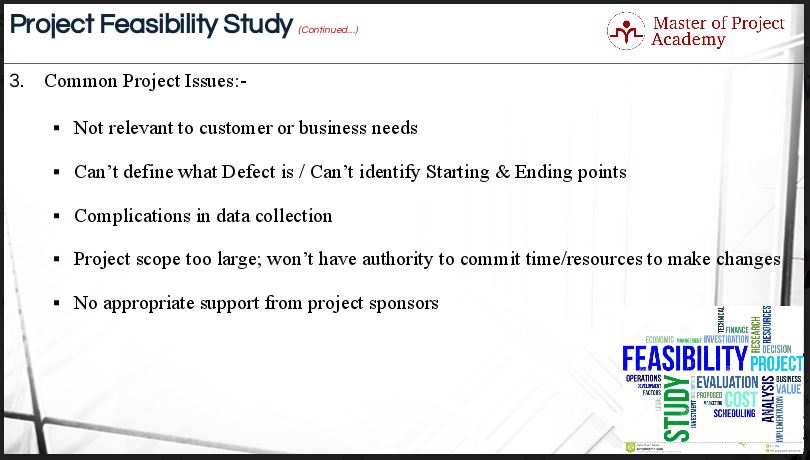Before we can talk about the concept of a ‘Project Feasibility Study’ we first need to understand what a feasibility study represents. The project feasibility study is also known as viability study or feasibility analysis. As the title suggests, this technique is used to determine the feasibility of a business problem or improvement opportunity. This is an important step when taking the Six Sigma approach to problem-solving. Online Six Sigma training elaborates on how the project feasibility study fits into the “Define” phase of the Six Sigma DMAIC process.
Attend our 100% Online & Self-Paced Free Six Sigma Training.
The results of this project feasibility study are used in making the decision whether to proceed with the project or not. The objective of such a study is to ensure that a project is legally, technically, financially, and operationally feasible. The study tells us whether a project is worth the investment or not. Most importantly, a project feasibility study evaluates the project and its potential for success. If the study has any errors, then there is a definite chance that your project will fail. This is how the importance of feasibility study can be explained.

Two criteria for judging a project feasibility study
There are mainly two criteria to judge feasibility in a project feasibility study according to Lean Six Sigma course. The first one is the cost required and the second one is the value to be delivered. A well-designed and well-planned study should offer:
- A historical background of the business problem or improvement opportunity
- A description of the product or service
- Accounting statements, details of operations and management
- Marketing research and policies
- Financial data, legal requirements and tax obligations
Key reasons for conducting a project feasibility study
There are a few key reasons for conducting a project feasibility study which is as follows:
- Not every project is doable
- Not every project should be taken up. This will engage otherwise useful resources in a non-value add project
- Not every project makes effective use of the resources of an organization
It represents:
- A definition of a business problem or opportunity to be studied
- An analysis of the AS-IS level of operations
- A definition of customer requirements; could be your internal and external customer
- An agreed upon course of action
5 Benefits of conducting a project feasibility study
Let us quickly have a look at the 5 benefits of conducting a project feasibility study. Conducting a project feasibility study is always beneficial to the project. It gives all stakeholders a clear picture of the business problem or improvement opportunity under consideration.
1. Give valid reasons for undertaking the project
It helps the project team to identify valid reasons to undertake the project. Please remember that not every reason is actually a valid reason. It is equally important that the project team should be able to measure the validity of the reason in terms of data, facts, figures, etc. The project feasibility study helps the project team to measure the validity of the reasons for doing a project in a quantified manner. Our gut feelings do not hold any value here!
2. Make key decisions prior to the project kick-off
It helps project team make critical decisions prior to the project kick off. The crucial decision can be in terms of whether or not the project is doable, whether or not the project is operationally and financially viable etc.
3. Prioritize business problems and improvement opportunities
The project feasibility study helps project teams prioritize the business problems or improvement opportunity. Of course, the prioritization is done in a quantified manner.
4. Narrow down the scope of the project
The project feasibility study helps narrow-down the scope of the business problem under consideration. The business problem can be complex and vast in nature. In such a case, in order to reduce the complexity, it is necessary to narrow down the scope of the problem or improvement opportunity. One or two improvement projects cannot solve all problem of the organization. You will have to look at each business problem separately as long as none are co-related.
5. Determine the success rate of the project
The study helps enhance the success rate of the project by evaluating multiple parameters. The rule is simple! The project feasibility study has to be 360-degree. For the given business problem or improvement opportunity, the study shall be done considering all relevant parameters. It ensures project success on 95%+ occasions
Project Feasibility Study: Common organizational or project issues for success
For completing the project feasibility study successfully, we need to learn about the common project issues; which project teams normally come across.

The first common issue is that the project is not relevant to customer or business needs. Any Six Sigma project will certainly fail if it is not relevant to customer or business needs. Of course, it has to be a key business need. One project cannot address all business critical and non-critical problems. A project feasibility study will shed light on this issue.
The second issue relates to the inability to define any kind of defect or process boundaries. If the project team is not in a position to define one or more defects for the business problem under consideration, then possibly, the project feasibility study needs to be re-evaluated. Moreover, if the team cannot identify Starting and End points, then such issue has to be addressed on a high priority.
The third issue is all about the complications in data collection. The project team should always ensure, prior to the beginning of the project, that there are no complications in data collection. The Six Sigma method is rigorous and data-driven. Without sufficient data and information, the project team may not be able to proceed at all across various stages in the project journey. Without data availability, the project can also go on-hold. A project feasibility study helps to validate the methods of measurement.
The fourth issue relates to the project scope. It is practically possible that the business problem or improvement opportunity is so complex and vast that project team is not in a position to commit timelines and resources. No such business problems should be picked-up in one go. Slicing and dicing the problem by means of a project feasibility study can help with this.
The fifth issue relates to sponsorship support. Six Sigma is a top-down approach. The strategic blessings or complete buy-in from top management are critically needed for each and every Six Sigma project to succeed. A project feasibility study can provide all the ammunition needed to get buy-in from key decision makers.
Saving categories in a project feasibility study
The Six Sigma effort is often aimed at cost reductions by eliminating waste in terms of scrap, inefficiencies, excess material, rework and so on that are increasing costs but not adding value. As a general rule, organizations want all Six Sigma projects to produce financial benefits, either directly or indirectly, through cost reductions, revenue growth, balance sheet improvements or accomplishing strategic goals. Potential savings can be identified with a project feasibility study.
Hard savings
The hard savings help reduce costs or expenses and result in a financial improvement. The examples of Six Sigma projects, which are hard-savings oriented are EBITDA improvement projects, cost reduction projects, revenue enhancement projects, etc.
Soft savings
The soft savings are financial benefits that may occur as a result of a Six Sigma project but are not accountable as a direct result of the project. Soft Savings are calculated by using a rational assessment of the expected benefits and a probability analysis of their likelihood. To note in simple terms, soft savings are not recorded in the financial statements of the project or process, unlike hard savings.

It is quite possible that a Six Sigma project would deliver both hard and soft savings in one single project. For example, because of a Six Sigma project, customer satisfaction level may increase and as a result, the customer may place more orders. In this case, an increase in customer satisfaction is a kind of soft saving. Any additional business or sales from the existing customer base, which can be attributed towards the extent of increase in customer satisfaction, helps generate hard savings. Let us understand the linkage here. Any marginal or substantial increase in sales will be accounted under Trading P&L statements. Increased sales can also result in increased profitability for the business unit; which is a kind of hard saving. A project feasibility study will help to identify where the savings will come from.
Please note that the project team should be in a position to quantify customer satisfaction beforehand. The quantification of customer satisfaction can be in terms C-Sat Score or NPS score. C-Sat or NPS reports help business unit measure customer satisfaction. As a rule of thumb, please remember that what gets measured always gets improved! The project team should be able to measure customer satisfaction to improve it.
5 Areas of a Project Feasibility Study
There are five areas of feasibility or 5 types of feasibility study, that is measured in a project feasibility study that we have listed here. Let us have a look the components of a feasibility study quickly.
Technical Feasibility
Under technical feasibility, the assessment is centered on the technical resources available for the project. It helps organizations assess whether the technical team is capable of converting the ideas into working systems or not. Technical feasibility also involves evaluation of the hardware and the software requirements of the proposed system.
Economic or financial feasibility
Economic feasibility of a project helps organizations assess the viability, cost, and benefits associated with projects; before financial resources are allocated. It helps decision-makers determine the positive economic benefits to the organization that the proposed system will provide, and helps quantify them too. This assessment typically involves a cost/ benefits analysis of the project.
Legal feasibility
This area investigates if the proposed system conflicts with legal requirements like data protection acts or social media laws.
Operational feasibility
This study helps analyze and determine whether the business needs can be fulfilled using the proposed solution or not. It helps to study if the business problem is worth solving.
Scheduling feasibility
Scheduling feasibility is the most important for project success. A project will fail if not completed on time. In scheduling feasibility, project teams estimate how much time the project will take to complete.
Now that was a lot of information on why a project feasibility study is so important. Let’s remember the most important take away regarding the project feasibility study. A project feasibility study is the first step in kick-starting your Six Sigma project!



One thought on “5 Areas of a Project Feasibility Study in Six Sigma”
Comments are closed.